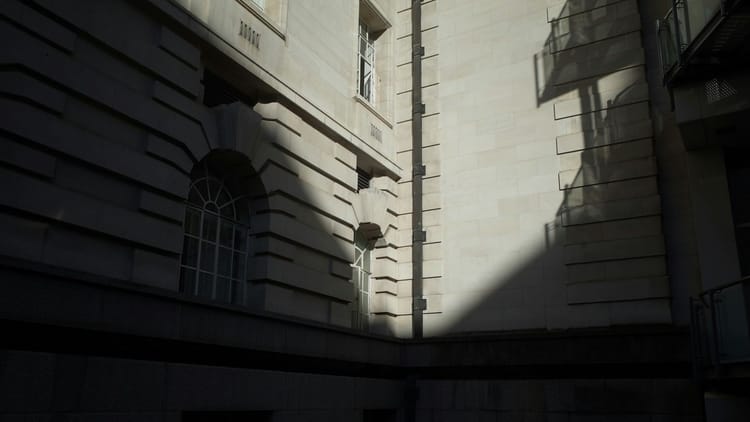The plan on the table

Recently: Loyalty tests and legal standards. Fighter jets and calculated confusion. &c. | The member’s despatch, Week XXXIX.
Today: Can a plan work when its vagueness is the point? The White House released a 21-point proposal to end the war in Gaza on Monday—and it seems written for different parties to read different deals into it.
+ For members: Want to lay criminal charges against a political enemy when a career prosecutor says there isn’t enough evidence? No problem.
& New music from Anna of the North ...
Developments
- Trump and Netanyahu, fourth time. U.S. President Donald Trump met Israel’s Prime Minister Benjamin Netanyahu at the White House on Monday for their fourth discussion since January, as the administration released a 21-point plan to end the war in Gaza. Netanyahu has indicated reservations about key elements—including any role for the Palestinian Authority or references to Palestinian statehood aspirations—despite Trump’s social media declaration that “ALL ARE ON BOARD FOR SOMETHING SPECIAL.”
- Federal forces in American cities. Armed federal agents in tactical gear patrolled downtown Chicago’s shopping districts Sunday, while Trump announced on Saturday that he’s directing the Pentagon to send troops “to protect War ravaged Portland” and ICE facilities there from “Antifa, and other domestic terrorists.” Oregon’s Governor Tina Kotek and Portland’s Mayor Keith Wilson dispute Trump’s characterization of the city, with Kotek saying there is “no national security threat in Portland” and Wilson adding that “the number of necessary troops is zero.” The National Guard is also expected to deploy to Memphis this week.
- Iran puts an alleged spy to death. Iran executed a man it identified as Bahman Choubi-asl on Monday, with the judiciary calling him “one of the most important spies for Israel in Iran.” According to the judiciary’s Mizan news outlet, Mossad recruited Choubi-asl to steal databases from Iranian government institutions and breach Iranian data centers. Executions of Iranians for spying have increased significantly this year, with at least 10 death sentences carried out in the last few months—part of an escalating shadow war between the two countries that turned into direct conflict in June when Israel struck targets inside Iran. … See, “The enemy of my enemy is still my enemy.”
- Washington on the brink. The U.S. federal government faces a shutdown on Wednesday if Congress can’t strike a funding deal by Tuesday night. Trump met Monday with the top four congressional leaders—House Speaker Mike Johnson, Senate Majority Leader John Thune, House Minority Leader Hakeem Jeffries, and Senate Minority Leader Chuck Schumer—but the meeting appeared to worsen prospects rather than improve them. “I think we’re headed to a shutdown,” Vice President J.D. Vance said afterward, with Schumer confirming “very large differences.” Republicans are pushing for a “clean” continuing resolution; Democrats want commitments on health-care subsidies.
- Sunday morning in Michigan. At least four people were killed and eight injured Sunday after a gunman rammed his vehicle through the front doors of the Church of Jesus Christ of Latter-day Saints in Grand Blanc Township, opened fire with an assault rifle on hundreds of worshippers, then deliberately set the building ablaze. Police killed the suspect, Thomas Jacob Sanford, a 40-year-old Iraq War veteran, in the church parking lot. The FBI is investigating the attack as ’targeted violence,’ though the motive remains unclear—including whether it might connect to the death on Saturday of Russell M. Nelson, the LDS church’s 101-year-old president. … See “Present tense: The question of political violence in America.”

The plan on the table
Trump’s 21-point proposal for Gaza, shared with Arab and Muslim leaders at the UN General Assembly last week, calls for Hamas to release all 48 remaining captives—about 20 believed alive—within 72 hours of an agreement. Israeli forces would then withdraw in phases toward a permanent ceasefire. The plan bars the forced displacement of Palestinians, allows significant humanitarian aid administered by the UN, and proposes two governance tiers: an overarching international body, called the “Board of Peace,” chaired by Trump himself, and a Palestinian committee, explicitly denying Hamas any future role. It recognizes “aspirations” for Palestinian statehood—language Netanyahu’s far-right coalition partners Bezalel Smotrich and Itamar Ben-Gvir have already attacked, threatening to collapse Netanyahu’s government if the war should end before Hamas is destroyed.
The plan proposes terms that key parties are already violating or rejecting. Trump has expressed growing frustration with Netanyahu, particularly after an Israeli strike targeting Hamas officials in Qatar—a key mediator—earlier this month appeared to derail negotiations. Yet Netanyahu told Fox News on Sunday he hopes to “make it a go,” even as he continues Israel’s intensifying offensive in Gaza City and insists the campaign won’t end until Hamas is eliminated. Hamas said Sunday it hasn’t received any new proposals through the mediators Egypt or Qatar.
The structure of the plan itself suggests the extent of the ambiguity ahead: barring forced displacement while Netanyahu’s coalition openly advocates “voluntary migration” of Palestinians; proposing international oversight of reconstruction while Israel maintains military control; recognizing Palestinian statehood aspirations while Netanyahu declares at the UN that such a state would be “like giving al-Qaeda a state one mile from New York City after September 11.”
Trump’s proposal attempts to thread together very disparate—and to date, irreconcilable—positions currently: Trump’s desire to claim a historic deal, Netanyahu’s need to satisfy key coalition partners pushing for Gaza’s permanent occupation, and international demands for Palestinian self-determination—itself a particularly difficult proposition, given the chronic lack of any truly functional democratic governance in Gaza or the West Bank.
In all the chaos of the moment, the plan’s vagueness may be its main selling point—allowing each party to claim agreement now while deferring the actual fight over what they’ve agreed to until implementation, if it ever comes. Which may well be all Trump is looking for right now.
Wary of fast fashion?
Shop Congo Clothing Company and
make a difference—in style.

For members
The case for the prosecutions
On the afternoon of September 20, last Friday, Erik Siebert cleared out his desk at the U.S. Attorney’s Office for the Eastern District of Virginia. The career prosecutor had declined to bring charges against former FBI Director James Comey, New York Attorney General Letitia James, and others after his staff concluded the evidence didn’t support any prosecutions.
By Monday morning, Lindsey Halligan took the oath as Siebert’s replacement. Halligan had never prosecuted a criminal case in her life. Her most recent previous job had her removing “improper ideology” from museums belonging to the Smithsonian Institution in Washington, D.C., as a White House aide. Before that, she’d represented U.S. President Donald Trump as his personal defense attorney.
By Thursday afternoon, she stood in a federal courthouse in Alexandria, Virginia, securing Comey’s indictment with one day left before the five-year statute of limitations expired. The charging documents bore only Halligan’s signature—no career prosecutors joined the case.
Meanwhile, Aakash Singh in the Deputy Attorney General’s office sent directives to at least six U.S. attorney offices instructing them to investigate George Soros’s Open Society Foundations on potential charges ranging from material support for terrorism to racketeering. The memo cited a report from the Capital Research Center, a conservative watchdog group that claims Soros has “poured over $80 million into groups tied to terrorism or extremist violence.”
Why’s all this happening now?
Your loyal guide to a changing world.
Membership with The Signal means exclusive access to premium benefits:
- Regular profiles on the questions behind the headlines
- In-depth feature interviews with our network of specialist contributors from across America and around the world
- The despatch, our weekly current-affairs and cultural-intelligence briefing
- Early access to new products, including print extras
It also means vital support for an independent new enterprise in current-affairs journalism.
New music
‘Give Me Your Love Back’
Here we have the B-side of the single from Anna of the North, the Oslo-based singer and songwriter we featured last week. On this other track, more romantic disappointment: She’s been dropped, and she’s taking out her frustrations on, at least here in this video, a big stuffed bear. Clearly, this wasn’t the way she planned for things to go.





